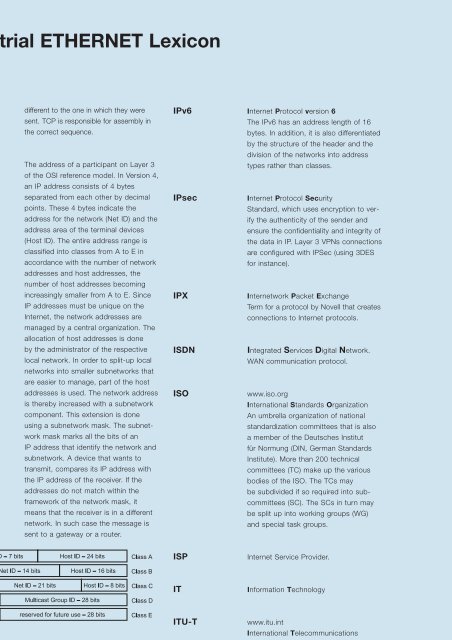Industrial ETHERNET
Industrial ETHERNET
Industrial ETHERNET
- No tags were found...
You also want an ePaper? Increase the reach of your titles
YUMPU automatically turns print PDFs into web optimized ePapers that Google loves.
<strong>Industrial</strong> <strong>ETHERNET</strong> Lexicon<br />
different to the one in which they were<br />
sent. TCP is responsible for assembly in<br />
the correct sequence.<br />
IP Address The address of a participant on Layer 3<br />
of the OSI reference model. In Version 4,<br />
an IP address consists of 4 bytes<br />
separated from each other by decimal<br />
points. These 4 bytes indicate the<br />
address for the network (Net ID) and the<br />
address area of the terminal devices<br />
(Host ID). The entire address range is<br />
classified into classes from A to E in<br />
accordance with the number of network<br />
addresses and host addresses, the<br />
number of host addresses becoming<br />
increasingly smaller from A to E. Since<br />
IP addresses must be unique on the<br />
Internet, the network addresses are<br />
managed by a central organization. The<br />
allocation of host addresses is done<br />
by the administrator of the respective<br />
local network. In order to split-up local<br />
networks into smaller subnetworks that<br />
are easier to manage, part of the host<br />
addresses is used. The network address<br />
is thereby increased with a subnetwork<br />
component. This extension is done<br />
using a subnetwork mask. The subnetwork<br />
mask marks all the bits of an<br />
IP address that identify the network and<br />
subnetwork. A device that wants to<br />
transmit, compares its IP address with<br />
the IP address of the receiver. If the<br />
addresses do not match within the<br />
framework of the network mask, it<br />
means that the receiver is in a different<br />
network. In such case the message is<br />
sent to a gateway or a router.<br />
IPv6 Internet Protocol version 6<br />
The IPv6 has an address length of 16<br />
bytes. In addition, it is also differentiated<br />
by the structure of the header and the<br />
division of the networks into address<br />
types rather than classes.<br />
IPsec<br />
Internet Protocol Security<br />
Standard, which uses encryption to verify<br />
the authenticity of the sender and<br />
ensure the confidentiality and integrity of<br />
the data in IP. Layer 3 VPNs connections<br />
are configured with IPSec (using 3DES<br />
for instance).<br />
IPX<br />
Internetwork Packet Exchange<br />
Term for a protocol by Novell that creates<br />
connections to Internet protocols.<br />
ISDN<br />
Integrated Services Digital Network.<br />
WAN communication protocol.<br />
ISO<br />
www.iso.org<br />
International Standards Organization<br />
An umbrella organization of national<br />
standardization committees that is also<br />
a member of the Deutsches Institut<br />
für Normung (DIN, German Standards<br />
Institute). More than 200 technical<br />
committees (TC) make up the various<br />
bodies of the ISO. The TCs may<br />
be subdivided if so required into subcommittees<br />
(SC). The SCs in turn may<br />
be split up into working groups (WG)<br />
and special task groups.<br />
ISP<br />
Internet Service Provider.<br />
IT<br />
Information Technology<br />
ITU-T<br />
www.itu.int<br />
International Telecommunications<br />
Union-Telecommunication<br />
Standardization committee with its head<br />
office in Geneva.<br />
IPv4 Internet Protocol version 4<br />
The IPv4 has an address length of<br />
4 bytes. Also see IP.<br />
Jabber<br />
Jitter<br />
Term for an <strong>ETHERNET</strong> packet with<br />
more than 1522 bytes.<br />
Term for the oscillation of signal edge<br />
in time.<br />
270











